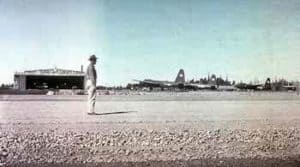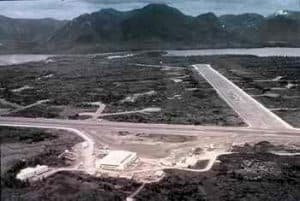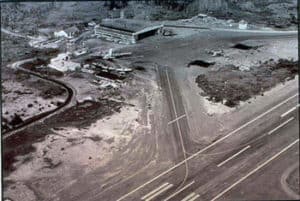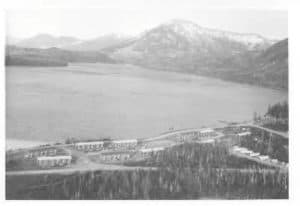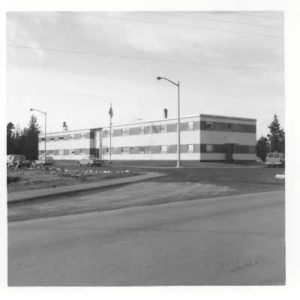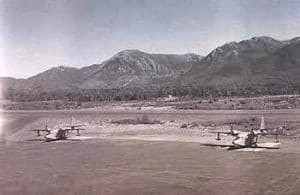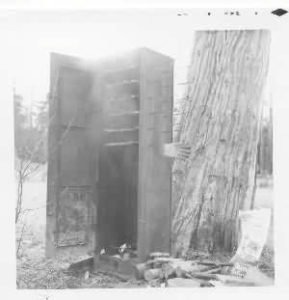Annette Air Station: Penal Colony or Paradise?
by Cdr John R. Butler USCG (Ret)
(NOTE: This article was written as the author completed two years as Executive Officer at CGAS Annette, and was published in the July/August 1971 issue of the Coast Guard Alumni Bulletin. There are minor updates and changes in tense to that original article.)
I had a pet theory about the old Annette Air Station of Southeast Alaska, now replaced by the Sitka Air Station. I called CGAS Annette “The most elite military unit in the world.” Here was my supporting logic: We naturally, as Americans, concede that our country is the most progressive in the world. And, of course, we in the Coast Guard know that we are members of the most exclusive military service – no draftees back in the old military draft days, higher entrance standards, and more career incentives.
As this point I have to make my humble apologies to my black shoe brothers, for I feel that aviation does have an edge on talent. Not that the best necessarily go into it, but our initial standards are generally higher. Therefore I deduce that, within the Coast Guard, aviation is the more elite duty. And of all the Air Stations, Annette received the greatest consideration in the assignment of personnel, officer and enlisted, for the flying was acknowledged to be the most demanding of mature talent, and the isolated living was just as demanding on man, wife and child.
So it should be plain to see that Annette was the most elite military unit in the world! If Sitka has now taken that strange honor, someone else will have to provide the twisted logic of justification!
Does that distinction clash with the usual stories you may have heard of Annette, the ones that likened it to a Siberian prison camp, where the inmates were the dregs of the Guard, sent to do penance for undisclosed sins?
There was, of course, much basis in fact for the grim pictures usually painted of Annette – the flying was generally tough, the weather is still generally poor, and the isolation was severe. The barracks and quarters used to be primitive. The safety record had been less than enviable.
For sixteen years I had heard friends and acquaintances curse when ordered to Annette, wondering who hated them that much. From the “stories” I had heard of Annette, I could fully understand and sympathize. But the thing I never could understand was why so many voluntarily extended their tours, spoke so fondly of it after they had left, and even asked for a second tour of duty there!
I was among the dismayed when I got my orders to Annette in the summer of 1969. I hadn’t asked for them, didn’t want them, and wondered if I could “get out of them.” But I didn’t try, so as my tour ended, I wanted to disclose some of the secrets of Annette–the good things about it you so rarely heard mentioned.
Perhaps the most universal, (and in my opinion poorest), advantage of duty there was expressed thus: $$$. Alaska living was every bit as expensive as people said, but the Cost of Living Allowance COLA) was fully adequate compensation. And even the casual hunter or fisherman could supplement the food budget to an extent that made it a cinch to save money on a tour.
I doubt that private housing was ever available, anywhere, that provided at a comparable cost (forfeiture of BAQ) the comfort and convenience of the family housing on Tamgas Harbor. Again, money could be banked.
Of course, the savings advantages leaned heavily to the married Coasties, but the singles still seemed to realize the difference at the end of a tour. The very isolation forced additional savings: there just weren’t as many places to go and spend money! The end result was that many, even if in debt on arrival, left with substantial savings.
For those who enjoyed the other aspects of life at Annette, the savings were a true bonus. For those who disliked Annette, they were at least a compensation. But the one who disliked Annette and extended a tour of duty for another year to realize more savings made it the hard and foolish way. Such extensions were strongly discouraged.
Next to saving money, the most often cited advantage of a tour at Annette was the environment. That is a pretty broad term to call an advantage, but it covered many aspects of the day to day living there. Broadly speaking, the environment was a relatively small island located in the Alexander Archipelago, at the extreme bottom of the Southeast Alaska “Panhandle.” The area is still noted for scenic beauty, isolation and outstanding hunting and fishing.
And those last three words were what struck a responsive chord with so many stationed there: hunting and fishing. For those that were experienced when they arrived, Annette could have been an unparalleled tour for expanding the horizons of game and fish. For the neophyte, it became an introduction that could establish a lifelong interest. Ducks, geese, deer, mink, wolves and beaver were plentiful on the island. Nearby islands, easily accessible by boat, expanded the game count to include mountain goats and brown, black and grizzly bear. Moose were also available within the panhandle.
Fishing went on the year around. The halibut caught in the cold, deep waters just south of the island have exceptionally fine flavored flesh. Deep frying in beer batter was one of the favorite means of preparation! King, silver and humpback salmon were available throughout the area, and large quantities were smoked and canned in the quarters area. The numerous fresh water lakes and streams abounded in cutthroat, steelhead and Dolly Varden, and even ice fishing was popular during the rare freezes. With this much water all around, you know the boating was good. When the weather was good, there was a mass exodus from the island as everyone took off to enjoy being on the water. Sailboats were a rarity due to the extremely high and gusty winds, but just about all other types were seen: dinghies, canoes, kayaks, small outboard and inboards, large speedboats with big outboards or inboard/outboard stern drives, and inboard cruisers up to 30 feet.
Our preference was an old, 1940 twin screw Owens Sedan cruiser, and during our last year my family and I took a leisurely cruise to Skagway and return, 1,000 miles of breathtaking beauty.
Of course, nothing is ever perfect, and even the fishing, hunting and boating have their drawbacks. For about six to eight weeks in the summer there were BUGS! The usual mosquitoes, of course, but they pale in comparison to the “white sox” and “no-see-ums.” When conditions were right (wrong?), they would swarm on you without being seen, bite without being felt. Your first clue was a drop or two of blood where you were bit. Then came a welt that would make a Louisiana mosquito cry in envy. Nickel to quarter size, bigger if you were allergic. Then days of really powerful itching. Bug repellents did help, but they were no cure-all.
Another frequently severe limitation to the great outdoor life was the sudden and severe storms. During the late spring, summer and early fall they mostly amounted to strong southeast winds running as high as 50 knots. In the early to midwinter there were the “Takus,” strong, cold, unpredictable northeast to east winds that could exceed 100 knots. Needless to say, any hunting, fishing or boating trip had to be planned with the utmost caution. The fatality rate in outdoor accidents was extremely high in comparison to other parts of the country. But this does not mean that outdoor sports were only for the foolhardy, just that planning was thrown into a real perspective here.
Which brings us to the biggest topic of conversation: weather. If you really couldn’t stand rain, then Annette was no place for you. We did get more than our share there – about 150 inches a year or more. Compare that with traditionally rainy CGAS Port Angeles and their 23 inches a year, or CGAS Mobile, one of the high recorders in the country with 67 inches a year!
In spite of this apparent deluge from the sky, the weather could be enjoyable – even exhilarating. When a big Arctic high set in over the area with light northerly winds and clear skies, there was probably no prettier place on God’s green earth. I would like to call that a frequent occurrence. Sorry. But even the “nasty” days – steady light to moderate rains for days on end with strong southwesterly winds – had a freshness I couldn’t recall back in the “south 48.”
My own theory is that weather is just a state of mind – if you can find enjoyment in it, then it isn’t all that bad. And after fighting the man-made weather of the big cities – smog and industrial haze – I will take the torrential Alaskan rains any day. In all sincerity, I missed the damnable weather when I left!
The weather, as well as the physical location, enforced the isolation, and this very isolation was alternately a blessing or a curse, depending on the background and mental makeup of the individual. There were many nonnative permanent residents on Annette, as well as other isolated Alaskan communities, who found the freedom from the fast pace of life to be exactly what they desired. They were, in a manner of speaking, “drop outs” from twentieth century life.
If you had ever thought that you would like to retreat from the mainstream for a while, duty at Annette could have been an answer. It could be a real balm to the weary soul. And It could also be two years of torture to the city dweller who could not adapt to the quiet life.
Even as the isolation may have proved to be either a plus or minus factor, depending upon the individual, so too was the government housing a mixed blessing. As a previous tenant of Air Force and Navy housing, I can truthfully say that our quarters were the finest we ever had. But others said the opposite. Again, a person’s background and temperament must have had a lot to do with it.
Roland Village was a group of fourteen apartment buildings, each housing four families in two, three and (rarely) four bedroom apartments. Each apartment was two storied, with private ground level entrances, two bathrooms, furnished with stove, refrigerator, washer, dryer, freezer and drapes.
There had been plans to furnish them completely calendar 1971, but budget problems temporarily halted the plans at that time. I don’t know if it was true, but I had heard at the time that they were built with an eye to the future, that they could be separated into manageable sections and barged to a new location. Did Roland Village wind up at Sitka? I don’t know.
Twelve of the units were completed in the mid-70s, the remaining two a few years later. The two new buildings were very close to the water, having just an access road separating them from the water’s edge. The twelve older apartments were built in two rows, five in front, with a large fenced playground for the kids, and seven behind.
For someone used to the isolation of country living, and looking forward to some of the same here, apartment living could be a shock. Soundproofing between the units was very good, but far from perfect. And the engineer who specified wall mounted toilets set back to back against a common wall (to save plumbing costs, I suppose) should spend the rest of his days playing bathroom teeter totter with the neighbors! Pity the hundred pound wife whose neighbor weighed 220.
Most parents were usually concerned about bringing their children to Annette, but for the pre- and early school child, this was really a paradise. They were normally too young to have been carefully taught that rain is nasty, that TV is essential, that crowds are healthy. Playing outdoors showed them some of the pleasures their grandparents must have known: hiking, fishing, tree house building.
The adequacy of the schools depended a lot on the child and what the child’s (or parents’) goals might have been. There was a relatively new grade school serving the Annette community. It was, in general, well liked. Rapid turnover of teachers was the school’s greatest problem. The only high school was in the native village of Metlakatla, some seven miles north of the Annette community. Classes had been meeting in temporary rooms in the basements of two churches after the high school burned down in February, 1970. A new school was constructed soon after, and the first occupancy had been scheduled for 1972. High school graduates were accredited for entrance to Alaskan colleges, but not otherwise.
Accreditation was not foreseen at that time. There were many reasons for that, the one seemingly insurmountable one being the lack of adequate housing for teachers. As the result, the teacher turnover rate was too high to provide the required continuity of instruction. The variety of subjects available was also quite limited, and a student contemplating college entrance would doubtless have found correspondence courses and entrance exams a necessity. For the student whose goal was to obtain a high school diploma in a friendly, small town atmosphere school, with lots of sports and social life, attendance at the Metlakatla high school could be a rewarding experience.
At the beginning of this article, I mentioned that the flying was generally tough and demanding. The terrain and the weather, the real culprits, never change, but more modern aircraft, navaids and attitudes about flying and safety did much to make the primary mission more safe and enjoyable. That primary mission was Search and Rescue, and this was accomplished, during my tour of duty, with the three assigned HH-52A Sikorsky Seaguard helicopters and two HU- 16E Grumman Albatross amphibians. The normal assistance cases were accomplished by the helicopters, usually amounting to medical evacuation of sick and injured persons, and searches for overdue boats and hunters. The fixed wing amphibian got in on a few of those, but spent most of its operational hours flying the “Alaska Patrol,” a weekly off shore sweep of the lucrative fishing grounds from Dixon Entrance, at the extreme southern end of Alaska, to Cape St. Elias, at the northern end of the Gulf of Alaska. The increased emphasis on international fishing treaties and pollution patrols would have indicated that the Albatross might have had a future in Alaska, but plans at the time were for three of the new HH-3F Sikorsky Pelican helicopters to replace the existing five aircraft in the summer of 1972.
And that was not the only change in the immediate future back in the early 1970s. Significant progress was being made on Gravina Island, just across the channel from the nearby city of Ketchikan, in the construction of a new airport designed to serve Southeastern Alaska. That airport, when completed, would essentially replace the existing Annette airport. What that might do to the future of the Annette Air Station was not clear at that time. Numerous proposals were under consideration, ranging from the unit remaining status quo (assuming that the FAA would continue the maintenance and control of the Annette Airport) to the Coast Guard taking control of the airport, to moving the entire unit to a more suitable and central location, such as Sitka. The future of the unit was strictly in the hands of the planners at that time.
With that indefinite future in mind, one might wonder how the Coast Guard got there in the first place. To help answer that, one had to back up even farther in time, back to 1887. That was when President Grover Cleveland gave Annette Island to the Tsimpshean (SIMP-sheann) Indians of Old Metlakatla, British Columbia. They came to Annette to escape religious persecution under the guidance of Father William Duncan, a redheaded Church of England Missionary. Father Duncan was a man of great wisdom and tolerance, and his lasting influence is still seen in the Duncan Memorial Church.
Much later, in 1939, the old Civil Aeronautics Administration was looking for a suitable place in Southeast Alaska for an airport. The small and flat portion of Annette Island proved to quite ideal, and permission was obtained from the Metlakatla Indian Community to construct an airport. Construction was started in 1940, under the Army Air Corps, and was completed about $18,000,000 later. Building a large, all weather airfield on muskeg up to ten feet thick is neither easy nor cheap! The first plane landed in February of 1942, and Annette had been a part of the Air Age ever since.
The Coast Guard had a “growed like Topsy” career at Annette, beginning with the assignment of one JRF Grumman Goose amphibian, plus pilots and crew, in the spring of 1944. Another Goose was added in 1946, and a PBY Consolidated Catalina spent the winter of 1947-1948 there. The Geese remained until relieved by the Albatrosses in 1952, and 1964 saw the addition of the Seaguard turbine powered helicopters.
Some permanence came when the new enlisted and officer barracks building was completed in 1961, and the completion of the family quarters in 1965 and 1969 made Annette one of the Coast Guard’s more modern and progressive units. Yet, all the facts, figures and history cannot really explain the lure of duty at Annette. Perhaps it was the closeness to nature at her beautiful best. (As compared to our usual closeness, as a matter of emergency business, to nature at her ugly worst.) As I wrote this, I watched a Northwestern Great Blue Heron fishing on the tidal flats in front of my quarters, occasionally spreading his six foot wings to fly/hop to another spot a few feet away.
Across the bay, above the high tide mark, were still the remains of a large whale, driven there by killer whales. Any day you could hike there and watch six or more Bald Eagles feeding on the carrion. Seals were common visitors to our harbor. Ravens, in the great spruce and hemlock in my front yard, cooed like happy babies. Even when the weather was only suitable for ducks, Mallards and Mergansers were seen paddling out front in Tamgas Harbor.
Minus tides meant good crabbing, and Dungeness crabs were usually available in my front yard. The wide tide range, sometimes over twenty three feet from one high to the next low, provided an ever changing view out our picture window. The snow line on Purple Mountain changed daily. By August, only Tamgas Mountain, at 3,600 feet the highest on Annette Island, would still have snow remaining.
So what was the secret of Annette? To me, at least, it was a two year respite from the dirt and din of civilization, a return to the simple life.

